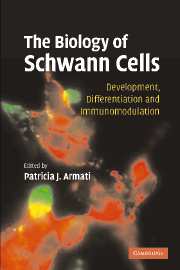Book contents
- Frontmatter
- Contents
- Preface
- Contributors
- 1 Introduction to the Schwann cell
- 2 Early events in Schwann cell development
- 3 The molecular organisation of myelinating Schwann cells
- 4 The role of the extracellular matrix in Schwann cell development and myelination
- 5 The biology of perisynaptic (terminal) Schwann cells
- 6 Cytokine and chemokine interactions with Schwann cells: the neuroimmunology of Schwann cells
- 7 Schwann cells as immunomodulatory cells
- 8 Mutations in Schwann cell genes causing inherited neuropathies
- 9 Guillain–Barré syndrome and the Schwann cell
- 10 Chronic idiopathic demyelinating polyneuropathy and Schwann cells
- References
- Index
- Plate section
9 - Guillain–Barré syndrome and the Schwann cell
Published online by Cambridge University Press: 13 August 2009
- Frontmatter
- Contents
- Preface
- Contributors
- 1 Introduction to the Schwann cell
- 2 Early events in Schwann cell development
- 3 The molecular organisation of myelinating Schwann cells
- 4 The role of the extracellular matrix in Schwann cell development and myelination
- 5 The biology of perisynaptic (terminal) Schwann cells
- 6 Cytokine and chemokine interactions with Schwann cells: the neuroimmunology of Schwann cells
- 7 Schwann cells as immunomodulatory cells
- 8 Mutations in Schwann cell genes causing inherited neuropathies
- 9 Guillain–Barré syndrome and the Schwann cell
- 10 Chronic idiopathic demyelinating polyneuropathy and Schwann cells
- References
- Index
- Plate section
Summary
THE DEFINITION AND THEN SUBDIVISION OF GUILLAIN–BARRé SYNDROME
Guillain–Barré syndrome (GBS) emerged from the confusion of nineteenth century descriptions of paralytic disorders with the descriptions of two case histories by Guillain, Barré and Strohl in 1916 (Guillain et al. 1916; Pritchard and Hughes 2004). Their patients had an acute paralysing disorder characterised by absent tendon reflexes and an increased cerebrospinal fluid protein with a normal cell count. They deduced that the disease involved the spinal nerve roots and Guillain insisted that it had a benign prognosis. This statement is sadly not true but does reflect the regenerative capacity of the Schwann cell, which turned out to be the principal focus of the pathology in the common form of the disease.
During the 1970s and 1980s the clinical picture was pinned down by a working definition which has continued in use (Asbury et al. 1978; Asbury and Cornblath 1990). The definition has inclusion criteria of progressive weakness of the limbs reaching its worst typically within four weeks, associated with loss or substantial loss of the tendon reflexes. It also has criteria of features which cast doubt on the diagnosis, such as marked asymmetry or bladder and bowel dysfunction at the onset, and exclusion criteria of alternative diagnoses, such as porphyria or toxin exposure. The characteristic features of GBS are that it occurs after, not during, an infection and that the pathology is largely confined, like Schwann cells, to the peripheral nervous system (PNS).
- Type
- Chapter
- Information
- The Biology of Schwann CellsDevelopment, Differentiation and Immunomodulation, pp. 158 - 170Publisher: Cambridge University PressPrint publication year: 2007



